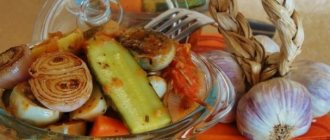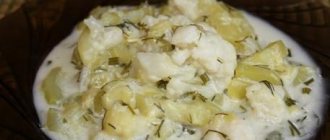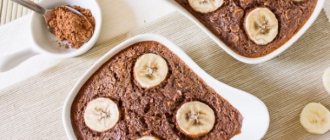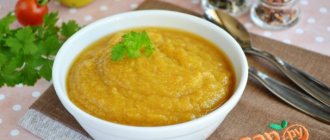3
Prepared by: Katerina
11/15/2019 Cooking time: 30 min
| Save | I cooked) | Estimate |
Most vegetables have low calorie content, which means they are great for weight loss! I offer you a recipe for delicious and healthy stewed vegetables. The dish turns out bright, light and quick to prepare!
Recipe for “Vegetable stew without oil”:
Subscribe to the Povarenka group on VKontakte and receive ten new recipes every day!
Join our group on Odnoklassniki and receive new recipes every day!
Share the recipe with friends:
| BB embed code: BB code is used on forums |
| HTML embed code: HTML code is used in blogs, such as LiveJournal |
How will it look like?
Similar Recipes
Natural eggplant salad
- 1
- 47
- 6089
Carrot zrazy with raisins, apple and nuts
- 51
- 108
- 6870
Bulgarian baked eggplants
- 52
- 1053
- 38831
Potato-cheese cutlets
- 8
- 218
- 2289
Braised cabbage
- 11
- 38
- 14386
Stewed zucchini (mom's recipe)
- 10
- 120
- 12515
Potatoes with mushrooms in the sleeve
- 27
- 51
- 35740
Latkes with cranberry apple sauce
- 14
- 18
- 1209
Corn fritters
- 23
- 98
- 1247
Try cooking together
German Potato Salad "Family Tradition"
- 126
- 1333
- 29974
Snack rolls
- 155
- 921
- 359757
Chocolate blueberry pie
- 34
- 608
- 6333
Comments and reviews
- All
- Prescription questions
- Reviews
March 7 patapeika # (recipe author)
March 3 patapeika # (recipe author)
Leave a comment or review about the recipe
Register, or log in if you have already registered.
You can log into the site without registering or entering a password by using your account on the following sites:
Stewed vegetables can be either a main hot dish or an excellent side dish for meat or fish delicacies. Stewed vegetables can always be prepared in different ways. Just add a new seasoning or a delicious sauce, and the vegetable mix will sparkle with a new taste. That is why vegetable stew is an absolute find for every cook.
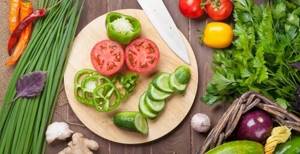
The good news is that almost all representatives of vegetable groups can be stewed. Vegetables go perfectly together, both fresh and frozen. However, you should take into account the fact that vegetables have different cooking times. For example, tomatoes should be added much later than cabbage or radishes. And if the recipe includes ingredients such as beans or beans, then they are prepared in advance, only then added to the vegetables.
Herbs will help decorate the dish or add a piquant taste: dill, parsley, mint, bay leaf, savory, lemon balm and basil.
Methods for stewing vegetables
The taste of stewed vegetables directly depends on the cooking method: they can be stewed in a frying pan, in cast iron pots in the oven, in a slow cooker or over an open fire.
When choosing a method, you should focus on personal taste preferences, because each option has advantages and disadvantages.
Stewing in a frying pan. For this method, vegetables require pre-frying. Stewing in a frying pan is suitable for preparing a small number of servings. Many people prefer this method due to the speed of preparation. Vegetables acquire a golden color and juicy taste. There are only three drawbacks: there is a high probability of burning, constant stirring and control of moisture evaporation are necessary.
Vegetables baked in the oven in their own juice will undoubtedly delight the whole family. In ceramic or clay dishes, vegetables are imbued with an unsurpassed aroma. In pots, dishes are divided into portions and are ready for original serving. There is also a minus: cooking will take much longer compared to the previous method.
When choosing a cooking method over an open fire, you should prepare for a long wait. However, it will be justified by an incomparable result. Thanks to the thick walls of cast iron cookware and a tight lid, vegetables will not burn, and the taste will be excellent.
A slow cooker is a salvation for everyone. Advantages of a multicooker: does not require any control, fast cooking and rich aroma. In addition, steaming helps to maximize the preservation of vitamins and nutrients. The only drawback is the possible dullness of the prepared vegetables. However, this can easily be eliminated by adding your favorite sauces and herbs.
General recommendations on how to properly stew vegetables
Vegetables should be washed and peeled immediately before cooking. This will preserve all the beneficial properties, vitamins and natural aroma. Cut vegetables as desired: into cubes, cubes, circles or strips.
Constant monitoring of the extinguishing temperature is necessary. It shouldn't change. For the oven, no more than 170 degrees; for the stove, it should not exceed 82. That is, the released juice should barely boil.
Pre-cooking the vegetables in their own juice or a small amount of liquid will improve the taste of the dish. That is, you should let them in in advance. Moreover, each vegetable is cooked separately. To do this, pour water into the pan, place vegetables in one layer, close tightly and simmer at the optimal temperature (85-90 degrees) for about 10-15 minutes.
How to properly stew vegetables in a frying pan or in a saucepan?
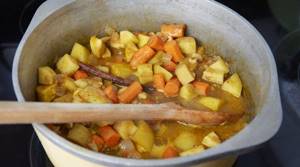
Vegetable stew is everyone’s favorite and unpretentious dish. The ability to cook differently every time is its main advantage. You just need to change the ingredients, seasonings or cutting form. Any vegetables that are available are suitable for cooking. It all depends on the time of year: tomatoes, zucchini, pumpkin, carrots, potatoes, all varieties of cabbage, onions, sweet peppers, etc. It is possible to use frozen vegetables.
Ingredients:
- half a kilogram of potatoes; - 2-3 carrots; — turnip — 2 pcs. (you can take rutabaga); — onions — 2 pcs.; — tomato — 2 pcs. (if not available, should be replaced with tomato paste); - 300 grams of cabbage; - beans as desired (the ratio of beans to vegetables is 1:4).
Vegetables are chopped into strips or cubes to the desired size. The cabbage must first be half cooked separately (simmered in a small amount of water). Fry the potatoes in a frying pan along with the onions, also until half cooked.
Next you need to prepare the spicy sauce. The simplest version of the sauce: fry a spoonful of flour in a heated frying pan, poured with oil. Next, add a little vegetable broth or water (about 300 ml), chopped tomato or tomato paste. Bring everything together to a boil.
Place raw eggplants and carrots, poached cabbage and fried potatoes in a container (saucepan or deep frying pan) and pour in the prepared sauce. To enhance the taste, add salt and pepper. The ideal spice is cloves. Simmer under a tight lid on the stove or in the oven for 20 minutes over low heat. It is necessary to ensure that
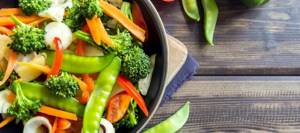
What will happen if I fry this delicious eggplant? Will the tomato retain all its wonderful properties if I add oil to the pan? Today we will tell you how best to cook vegetables in order to preserve the maximum of nutrients and nutrients. First, let's figure out what the difference is between stewing and frying.
Oil vs liquid

When braising, you use liquid, and when frying, you use oil or fat. Accordingly, during stewing you avoid the formation of carcinogens that are released from the oil during heating. By the way, a nice bonus is that adding water reduces the risk of the dish burning.
Temperature vs languor

The second difference is that during stewing, when the dish is simmered over low heat, beneficial nutrients are preserved, which are simply destroyed at high temperatures. For example, stewed mini broccoli contains 40% more vitamins than boiled one. Also consider the size of the vegetable: the larger they are cut, the less vitamins they lose.
So what, don't fry now? How crispy is the crust?! Don't be scared! You can fry, but be careful!
How to properly fry vegetables?

1. First of all, do not lean on the oil. It is high in fat, calories and, as we said above, it releases carcinogens when heated. Remember, oil is not a product you should skimp on, because it is about your health. Use only natural and high-quality oil. Note to the hostess: frying mixture with potatoes, beans and bacon - 10 minutes, and a complete finished dish is on the table! Or a compromise with the devil: grilled eggplants and zucchini. Invite your guests!
2. Before frying, steam the vegetables thoroughly, and only then place them in the frying pan. Not for long! Don't turn vegetables into charcoal, because the light crust is exactly what we appreciate this taste for! Alternatively, take steamed green beans and fry them for 1-2 minutes. Fast, tasty and healthy!
3. Use a non-stick frying pan with a thick bottom, high-density walls and a lid. On such a surface, food will not burn, and you can do without oil. Another way is to use parchment, sleeve, foil or paper that is placed at the bottom of the container. Diet food with low calorie content is guaranteed to you!
Stewed vegetable dishes
If you decide to stew vegetables, here are some recommendations.
Vegetable arsenal
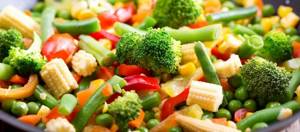
The most delicious and nutritious dishes are made from zucchini, white cabbage (everyone remembers stewed cabbage from kindergarten) and cauliflower, potatoes, carrots, sweet peppers and onions. You can prepare a quick and easy side dish or a full meal for dinner using already chopped broccoli, cauliflower and carrots. It is enough to simmer the vegetable mixture for a couple of minutes in a frying pan with a little water or in chicken broth, otherwise it will become too watery. Thin green beans make an appetizing and healthy side dish. The ends are already trimmed, so you will save your precious time!
How long to simmer

Vegetables are also prepared in different ways. For example, carrots, potatoes and cabbage need 20-30 minutes to be fully prepared - they are added first. Next come beets, green beans, onions - these vegetables are stewed for no longer than 15 minutes. At the very end, add tomatoes, zucchini or even sweet corn - they only need about 5 minutes. Don't forget to use spices, and pour olive oil on the plate with the finished dish, sprinkle with fresh herbs or even Parmesan! That's all for now! Do not forget that although raw plant foods contain more vitamins, it is from the stewed form that the beneficial substances are better absorbed. Moreover, if you don’t have a slow cooker, you can simply and quickly bake vegetables in the oven on a baking sheet or prepare a delicious stew of seasonal vegetables in pots.
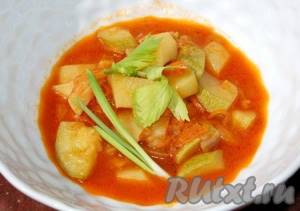
How to fry vegetables
Vegetables are fried raw or pre-cooked, poached or stewed. Raw vegetables and vegetable products are fried in two ways: the main way is in a frying pan (baking tray) or in fat, which is taken four times the weight of the immersed vegetables.
When frying in the main way, potatoes, vegetables and products made from them (cutlets, zrazy, etc.) are placed in a frying pan or baking sheet with fat, preheated to 160-170 degrees, and fried until a crust forms; If by this moment the product has not yet reached the state of readiness, it is finished cooking in the oven. To ensure that vegetables are fried evenly, they are placed in a frying pan or baking sheet in a layer of no more than 5 cm.
Frying in fat is done in deep pans, saucepans or special deep fryers. For these purposes, you can use a saucepan or stewpan with an inserted metal mesh.
This method is used to fry raw potatoes, cut into cubes or strips, onions, cut into rings, and other vegetables. Vegetables are immersed in fat heated to 180-190 degrees. When immersing food and frying, fat can foam a lot, so you should only fill the pan halfway with fat. When frying vegetables in a mesh, the mesh with the prepared vegetables is removed from the fat, the fat is allowed to drain, after which the vegetables are transferred to a baking sheet.
If vegetables are fried in a dish without a mesh, then when ready, remove them with a slotted spoon into a colander, which is held over the dish where the vegetables were fried, and when the fat has drained, they are placed in a baking sheet. Prepared vegetables are salted with fine table salt.
Vegetables are fried in combined animal fats and vegetable oil. It must be borne in mind that vegetable oil has the lowest smoke point and using it in its pure form for frying often leads to excessive smoke.
Animal fats (beef and especially lamb fat) have a higher melting point and for this reason quickly solidify on fried products.
It is better to use a mixture of vegetable oil and animal fat for frying (50% melted lard and 50% vegetable oil or 70 and 30%
Cooking steps
Peel the eggplant, cut into small pieces and fry in vegetable oil directly in the pan in which you will cook the vegetables.
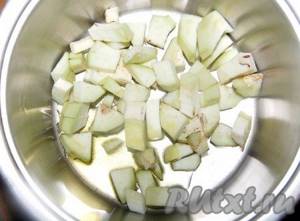
Cut the zucchini into small pieces.
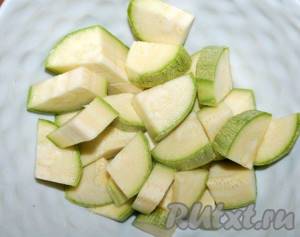
When the eggplant is sufficiently fried, add the zucchini pieces to the pan.

Fry for 7 minutes.

Cut the potatoes into small pieces.
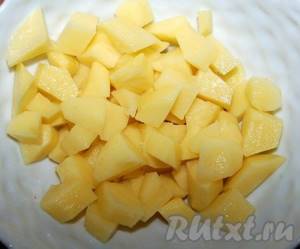
Add potatoes to the pan.
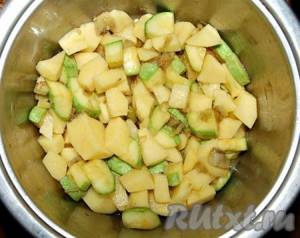
Grate the carrots on a coarse grater, chop the onion into small pieces and fry in a frying pan in vegetable oil.
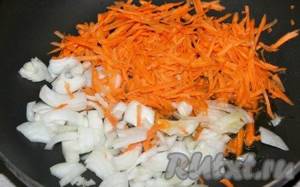
Fry until lightly browned.
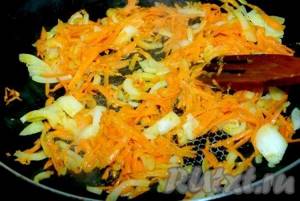
Then add tomato paste and continue frying until almost cooked.

Add the fried carrots and onions to the pan with the rest of the vegetables.
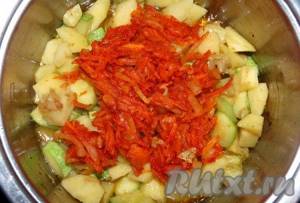
Add hot water, salt and pepper. The amount of water for stewed vegetables depends on your choice (whether you want it thinner or thicker). You can add some herbs (fresh or dried).
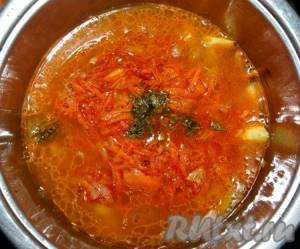
After adding water, simmer the vegetables for 10 minutes, then turn off the heat and you can start taking samples. Bon appetit!

How to prepare the dish “Stewed vegetables without oil”
- Wash and peel all vegetables.
- Cut the onion into half rings and the zucchini into cubes.
- Then place the vegetables in layers in a pan with thick walls in the following sequence: onions, carrots, zucchini.
- Cut the tomatoes into slices and add to the vegetables.
- Pour water, salt, add tomato juice.
- Simmer over low heat for 30 minutes.
- Onions - 1/2 pcs.
- Zucchini - 1/2 pcs.
- Tomato - 1 pc.
- Tomato sauce - 1 tbsp.
- Water - 200 ml.
- Salt - 2 gr.
Nutritional value of the dish “Stewed vegetables without oil” (per 100 grams):
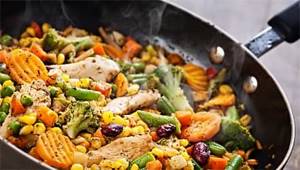
In cooking, stewing is a cooking procedure that is intermediate between frying and boiling. Stewing is always carried out under the lid in the presence of a small amount of liquid and fat. In addition to the classic extinguishing procedure, there are some less common varieties of this method:
- Poaching is simmering in a small volume of liquid for several minutes.
- Simmering is slow simmering over low heat for a long time.
- Confit - stewing in oil. Often used in French cuisine. Most often used for fish or meat. The extinguishing temperature should not exceed 100 degrees.
Cooking method
The stewing procedure is applicable for cooking vegetables, fish, poultry and meat, as well as fruits. Having much in common in the technology of preparing various products, stewing has a number of features that are used exclusively in certain cases.
Here are a few rules for properly preparing foods:
- Food is usually stewed in water, broths, and sauces. Particularly juicy products are in their own juice.
- Extinguishing is done over low heat.
- Tough meat is pre-marinated in wine or vinegar, or stewed together with sour vegetables, such as tomatoes or sour fruits.
- Stewing is always done under a lid, which, according to many culinary gurus, is best not to open until the end of cooking. Of course, if you know exactly the cooking time of the dish!
- Products intended for stewing are cut into identical portion pieces, which avoids deformation and under-braised parts of the dish.
Stewing vegetables
The most famous dish prepared using this method is vegetable stew. Of course, every housewife prepares this dish in her own way; we will give only the general technology for its preparation.
Vegetables intended for stewing are washed, peeled, and then chopped. Cut the potatoes into cubes and place them in a frying pan, then add water and simmer over medium heat (to prevent the potatoes from falling apart, you can first fry them in oil for 2-3 minutes until golden brown). Place pre-chopped onions and carrots in a separate frying pan, lightly fry, cover with a lid and simmer until half cooked.
Then they check the potatoes. When it is almost ready, finely chopped cabbage is added to it. After about a couple of minutes, add the stewed onions and carrots. Salt and spices are added to taste.
To ensure that the oil retains more nutrients, it can be added at the very end of cooking the stew. The preparation time of the dish takes about 40 minutes. You can add a variety of vegetables to the stew, experimenting with taste. Depending on the season, peppers, zucchini, cauliflower, asparagus, tomatoes and, of course, different types of greens are added there - all this will organically fit into the overall ensemble of taste of vegetable stew.
In addition to stews, the most popular vegetable dishes prepared by stewing include squash, beet and eggplant caviar, stewed potatoes with mushrooms, as well as the Hungarian national dish “leczo”.
Stewing meat and poultry
Meat or poultry, pre-prepared and cut into equal pieces, is flavored with spices. The meat is beaten. The finished products are placed in a well-heated frying pan in hot oil. Fry until golden brown for 2-3 minutes, then cover the pan with a lid and simmer until done. The golden brown crust resulting from frying prevents the juice from leaking out, making the meat very tasty, tender and juicy.
Poultry and meat acquire a particularly piquant taste after soaking them in a marinade for 8-10 hours (vinegar or wine with spices and a little mayonnaise)! Although this cooking option is often used in the holiday menu. It does not apply to dietary nutrition. Pickled foods are prohibited for people with many gastrointestinal problems.
Stewing fish
The fish is cleaned, freed from entrails and scales, and washed. If the fish is large, cut into pieces of the same size to ensure uniform cooking. Pour flour into a separate saucer and prepare salt.
The fish is salted, rolled in flour and placed in a frying pan in preheated oil. After a crust has formed, the product is turned over and lightly fried on the other side. Then add a little water and simmer until done.
Stewed zucchini with vegetables - how to stew zucchini in a frying pan and in a saucepan
Good afternoon.
As promised, I’m starting to carefully analyze recipes for preparing a wide variety of dishes that can be prepared from zucchini. Last time we looked at simple quick recipes, and today we will learn how to stew zucchini.
There are many ways here: you can cook them in the form of goulash or as a warm salad, you can use meat and minced meat as ingredients, or make a purely vegetarian dish.
It would also be an excellent solution to include stewed zucchini in your healthy diet, because it is no secret that this vegetable has a negative calorie content, which is important for people watching their diet.
And this is not even taking into account the fact that you can simmer not only in a frying pan. But more on that below.
In general, I have no doubt that today everyone will find a recipe “for themselves.”
Before we begin, I will note one more thing: there is nothing complicated in preparing these dishes, so I will not focus on step-by-step preparation. The only important things here are the proportions of the ingredients and the time until each of them is ready.
Well, now, finally, let's begin.
How to cook stewed zucchini with vegetables in a frying pan
Let's start with the most popular method of stewing - in a frying pan. This is one of the simplest and fastest options. The frying pan heats up evenly, nothing burns (if the frying pan is good) and all that is generally needed is to first fry the food a little, then add water or dressing and leave it to “simmer” under the lid.
Well, the aroma from fried vegetables is always pleasant and stimulates the appetite.
I offer you several interesting recipes with well-chosen ingredients.
Stewed zucchini with carrots and onions
One of the simplest recipes. We make a classic frying of carrots and onions, and then simmer the zucchini in it.
Ingredients:
- Zucchini - 1.5 kg
- Onion - 2 pcs (250 g)
- Carrots – 3 pcs (250 g)
- Salt - 1 tsp
- Vegetable oil for frying
- Ground black pepper - to taste
- Greens for garnishing the finished dish
Preparation:
1. Heat vegetable oil in a frying pan and fry the chopped onion over medium heat until it becomes translucent (5 minutes). Stir occasionally.
2. Then add the finely grated carrots to the onion and continue frying with stirring until the carrots soften. Now you can add zucchini, cut into small cubes.
3. Add salt and pepper, mix and cover with a lid. Reduce the heat to minimum.
Simmer the vegetables for 25 minutes, stirring occasionally.
You can add chopped herbs to the finished dish for flavor.
Ready. Bon appetit!
How to stew zucchini with tomatoes
The previous recipe can be made more interesting by including tomatoes. Thanks to tomato juice, it will taste completely different.
Ingredients:
- Zucchini - 2 pcs.
- Carrots - 1 pc.
- Tomatoes - 1 pc.
- Onion - 1 pc.
- Vegetable oil
- Salt, spices
Preparation:
1. Chop the onion and carrots and fry in a frying pan with vegetable oil for 6-9 minutes over medium heat until the vegetables soften. And at this time we do some magic with the tomato.
You need to make a cross-shaped cut on it and pour boiling water over it.
After which it is easy and effortless to remove the skin.
And cut into small cubes, which are then fried with onions and carrots.
2. Fry the vegetable mixture for 4-5 minutes, then add the chopped zucchini, stir and cover with a lid, after reducing the heat to low.
3. Simmer for 15-20 minutes, stirring occasionally.
Garlic lovers can add it by passing it through a garlic press about 5 minutes before the end of cooking.
Ready. Bon appetit!
Vegetable stew with eggplants, tomatoes and bell peppers
Now let’s mix all the seasonal vegetables into a pile and get a vitamin bomb. Yes, I know that some vitamins are lost when heated, but there will still be more than enough of them in this dish. And don’t forget about the fiber and microelements contained in vegetables - their importance for the body is no less.
Ingredients:
- 1 zucchini
- 1 eggplant
- 1 onion
- 1 carrot
- 1 bell pepper
- 2 tomatoes
- 30 ml sunflower oil
- Water – 100 ml
- Salt, pepper - to taste
Preparation:
All vegetables need to be washed and cut, following the rules familiar to everyone:
- The tails of the zucchini are cut off and cut into cubes. If the vegetable is not young, then you need to peel it.
- The eggplant is also cut into cubes after removing the tails.
- The onion is chopped or cut into half rings.
- Pepper is usually turned into strips, after removing the seeds and membranes from it.
- You can simply cut the tomato into slices, or you can first remove the peel, as shown in the previous recipe.
- Carrots are traditionally grated on a fine grater.
Place the vegetables prepared in this way into a deep frying pan, pour vegetable oil and water into it, mix, cover with a lid and place on low heat. Simmer for 20-25 minutes, stirring occasionally. About 5 minutes before the end, add salt and pepper.
Ready. Bon appetit!
on how to cook zucchini with vegetables and rice in a frying pan
Now I propose to move on to slightly more complex recipes, where other products are used in addition to vegetables. For example, here is a very tasty and satisfying way to stew zucchini with vegetables and rice.
Stewing zucchini in a frying pan with chicken breast
Let's move on to more substantial dishes with meat. And first, let's take chicken fillet. Tender chicken meat and stewed vegetables. What could be more satisfying and tastier?
Ingredients:
- Chicken breast – 500 onions
- Zucchini - 500 g
- Potatoes - 500 g
- Carrots - 1 pc.
- Onion - 1 pc.
- bell pepper
- Tomato paste - 1 tsp
- Water - 1/4 cup
- Salt, pepper mixture, dried herb seasoning - to taste
Preparation:
1. Heat the frying pan, then pour 100 ml of vegetable oil into it, wait for it to heat up, then lay out the fillet, cut into random pieces and fry it over medium heat until the meat turns white. This will take about 10 minutes.
2. Then add chopped onion, diced potatoes and continue to fry, stirring occasionally until the chicken becomes golden brown (10-15 minutes).
3. Next come all the remaining vegetables, also cut into small cubes and salt with spices.
Stir and fry for another 7 minutes so that the vegetables fry a little and release the aroma.
4. As a final touch, add tomato paste diluted in water, stir one last time, reduce the heat to low and leave to simmer for 5-10 minutes.
The readiness of the dish is checked by the readiness of the meat. If it is ready, then the vegetable stew is ready too.
Bon appetit!
Delicious recipe with vegetables, meat and potatoes
It may seem to you that this method is the same as the previous one, only the meat is different. But no. The difference here is that the vegetables are not pre-fried, which means they retain their juice, which remains in the pan. The result is not a stew, but rather a meat broth with vegetables. Delicious.
This method is very convenient for cooking in a cauldron somewhere in nature.
Ingredients:
- Pork – 500 g
- Zucchini - 1 piece
- Potatoes - 1 kg
- Carrots - 3 pcs.
- Onion - 1 pc.
- Bell pepper - 1 piece
- Vegetable oil - 2 tbsp
- Salt and spices - to taste
Preparation:
1. Cut the pork into large pieces (like shish kebab) and fry in a frying pan with vegetable oil over low heat for 20 minutes.
2. Then add coarsely chopped carrots and onions to the meat, add salt and pepper, mix and simmer under a closed lid for 10 minutes.
3. And lastly, add chopped potatoes, zucchini and pepper. Stir again, cover with a lid and simmer over low heat for 30 minutes.
As you noticed, in this recipe all ingredients are chopped coarsely. This is to make it easier to put on plates later.
That's all. It will take about an hour to do everything. Bon appetit!
How to stew zucchini with vegetables in a saucepan
A distinctive feature of cooking stewed zucchini in a saucepan is that the dish is cooked with gravy. Therefore, it can act both as the first and as the second. This is very convenient if, for example, you are on a diet and really want some broth.
In general, zucchini and vegetables cooked in a pan are much more dietary than cooked in a frying pan (since they contain less oil) and will fit perfectly into a healthy diet if you are on a diet or just watching your health.
If you are interested, then I offer 4 different options for stewing vegetables in a saucepan.
The simplest recipe for stewed zucchini with vegetables
The name speaks for itself: the whole difficulty lies in the preliminary cutting of the ingredients.
Step-by-step recipe for stuffed zucchini with minced meat
And this recipe will make you remember stuffed peppers. Indeed, they are very similar. But the walls of the zucchini are more durable and the finished dish can even be cut into rings - nothing will fall apart.
Ingredients:
- Zucchini - 3-4 pcs.
- 1 medium onion
- 1 carrot
- Minced meat – 500 g
For the gravy:
- Flour - 2 tbsp
- Tomato paste - 2 tbsp
- Water – 700 ml
- Sunflower oil - 4 tbsp
Preparation:
1. Cut the zucchini in half and scrape out the middle. The easiest way to do this is with a teaspoon. The wall thickness of the resulting form should not be more than half a centimeter. And there should be a bottom.
It is advisable to use zucchini of the same thickness, so that when stewing it does not turn out that some are already ready, while others are not yet.
2. Finely chop the onion and carrots or grate them and fry in vegetable oil until golden.
3. Mix the minced meat with fried onions, add salt and pepper and mix thoroughly until smooth.
4. Fill the zucchini molds with minced meat and place them upright in a pan.
5. To prepare the gravy, heat the sunflower oil and fry the flour in it over medium heat.
6. Then add tomato paste and fry it too.
7. Finally, add water, stir the mixture until smooth and wait for it to boil.
8. Pour the resulting gravy into the pan with the zucchini and place it over medium heat.
The gravy should almost completely cover the zucchini.
9. When the pan boils, reduce the heat to low, cover it with a lid and leave to simmer for 40 minutes.
Ready. Bon appetit!
Vegetable stew with tomatoes and tomato paste
This is an excellent universal recipe by which you can prepare a lunch dish and you can also use it to make preparations for the winter if you pour the resulting dish into sterilized jars. But we will talk about this in a separate topic a little later.
Ingredients:
- 1 medium sized zucchini
- 2 tomatoes
- 2 bell peppers
- 3-4 medium carrots
- 1 onion
- 2-3 cloves of garlic
- 250 g tomato paste
- 2 tbsp lemon juice
- Salt pepper
Preparation:
1. Chop onions and carrots and sauté in a saucepan with a small amount of vegetable oil until soft.
2. Add the diced zucchini, stir, close the lid and simmer for 8-10 minutes.
3. Then come small chopped tomatoes and bell peppers, which must also be mixed and simmered under the lid for 10 minutes.
4. As a finishing touch, add tomato paste, lemon juice, chopped garlic and salt and pepper. Stir and cover the pan for the last time for 10 minutes.
Ready. Bon appetit!
Original recipe for stewed vegetables in tomato juice
And finally, another interesting cooking option in which stewing takes place in tomato juice.
Ingredients:
- Zucchini – 600 g
- Garlic – 1 head
- Tomatoes – 300 g
- Greens (dill, parsley, onion) – 2-3 sprigs each
- Salt - to taste
- Italian seasonings – 1 tbsp
Preparation:
1. Cut the zucchini into rings about half a centimeter thick, add salt, add seasonings and mix thoroughly.
2. Take a saucepan or small saucepan and place the zucchini circles very tightly in it.
3. Grind the tomatoes in a blender along with the garlic.
If desired, the skins of the tomatoes can be removed first by pouring boiling water over them.
4. Pour the resulting juice over the zucchini and place the saucepan on low heat.
5. Sprinkle chopped herbs on top, close the lid and simmer for 15 minutes.
Ready. Bon appetit!
These are the interesting recipes I have collected in today’s article. But these are not all the ways. There are excellent options for stewing zucchini in the oven. They can be stewed either in a mold or in pots. Such options undoubtedly deserve attention and I will write about them in the near future.
That's all for today, thank you for your attention.
Source: https://easywaylife.ru/kabachki-tushenye-s-ovoshham.html
Useful properties of stewed food
Stewing is on the list of the healthiest cooking methods. This method is used by many people leading a healthy lifestyle. Stewing allows you to preserve a large amount of nutrients, which remain in the finished dish, and are not drained along with water, as, for example, during cooking.
From the point of view of maximum nutritional value of food, this method can be considered one of the most gentle, due to the preservation of a large amount of vitamins and microelements in the products.
The cooking process occurs at a temperature below the boiling point, which allows not only to preserve vitamins, but also the original shape of the dish.
In stewed form, animal and vegetable proteins are better absorbed due to the softening of fibers and tissues. And some foods even provide additional nutritional benefits. For example, during stewing, prunes acquire a sweet and piquant taste, and healthy enzymes are released.
Dangerous properties of stewed food
Excessive consumption of heat-treated food contributes to the deterioration of the gastrointestinal tract due to a lack of fresh plant fiber in the diet.
By eating only stewed food, you can acquire dysbiosis, worsen intestinal motility, and, in general, sabotage the normal functioning of the digestive organs.
In addition, during stewing, a gradual destruction of vitamins B and C occurs. Their amount is reduced in proportion to the cooking time.
General rules for stewing vegetables
— Vegetables must be thoroughly washed, peeled and cut into equal pieces, in the form of bars or cubes. It is recommended to peel and chop vegetables immediately before cooking in order to preserve the greatest amount of nutrients and natural flavor.
— The taste of the final dish will be much better if, before stewing vegetables, you simmer them in their own juice or in water until half cooked. Vegetables are laid out in a saucepan or saucepan in one layer and simmered under the lid. If several types of vegetables will be stewed, each type is cooked separately.
— During the cooking process, the boiling temperature should be constant, the liquid in which the vegetables are stewed should barely boil. When stewing on the stove, it is recommended not to raise the temperature above 82 °C; when stewing in the oven, it should not be higher than 170 °C.
— Zucchini, eggplant, potatoes, onions, tomatoes, mushrooms and asparagus are ideal for stewing. Experienced housewives stew potatoes with sweet peppers, raisins, prunes and pumpkin. Carrots are stewed with honey or prunes and are ideal for many sweet dishes. The most popular vegetable for stewing all year round is cabbage, which serves as an excellent side dish for meat and fish cutlets, any meat and fish, and is also an excellent and very tasty filling for homemade baked goods.
Many chefs recommend poaching vegetables before stewing, that is, boiling the vegetables in their own juice (water). To do this, you need to place the vegetables in one row on the bottom of the dish (layer thickness 15-20 cm), close the lid tightly, and simmer until half cooked at a low boil.
What's the best way to prepare a vegetable side dish?
13.05.2020
To prepare a vegetable side dish suitable for the main dish, you need to take into account a number of nuances. It’s not so easy to match the ingredients to each other, and even to the main product of the dish.
What kind of side dish is there?
When serving fish or meat, vegetables should not only complement, but also set off both in color and taste. In vegetarian cuisine, such an additive will be the basis.
A vegetable side dish is an addition to the main dish to increase the portion or improve the taste and quality. He can be:
- consisting of one component;
- from several ingredients;
- combined.
Both raw and heat-treated products can be served as a side dish. A raw vegetable addition is often called a salad, such as coleslaw. According to the method of preparation, the snack is:
- boiled, stewed;
- baked in the oven;
- fried, in the form of puree;
- fresh vegetables cut into pieces.
When choosing an additive for the main dish, you should think about everything down to the slightest nuance. The combination of flavors may be the most unusual, but adding herbs and spices can balance everything out. There are some rules in cooking, but taste is always the basis.
Features of stewing vegetables
You should pay attention to products whose texture changes greatly after cooking. These include zucchini, squash, and eggplant.
The side dish prepared from them is tasty, but does not hold its shape well, and the appearance requires correction. It is appropriate to cook and serve such products in portioned forms, pots, along with other vegetables.
It should be taken into account that the cooking time should not exceed 10–12 minutes, therefore, you cannot add zucchini and potatoes at the same time. The sequence could be like this:
If the texture of the dish does not matter, then you can add it at the same time. In this case, some vegetables will be whole after cooking, while others will turn into puree. Many people prefer this way of serving snacks.
A dish with eggplants can be combined with tomatoes. This additive will enhance the taste and aroma. It is appropriate to use basil, parsley or dill as herbs.
Spices used include cardamom, pepper and nutmeg. Oven-baked vegetables with eggplants and zucchini are very tasty hot. It is appropriate to serve them with not only meat, but also sauce. Garlic and sour cream can be added to its composition.
Vegetable side dish in the oven
You can cook the dish in the oven either together with the main dish or separately. For example, fish baked on a bed of vegetables will be cooked with a side dish. Place the fish, add spices and put it in the oven or microwave.
If the supplement is intended as an independent snack, proceed differently. Let's look at some options.
Baked potatoes with carrots
This dish can be prepared in foil or in a saucepan with a lid. A baking dish that can be easily covered with foil is quite suitable. You will need the following products:
- potatoes – 400 g, carrots – 100 g;
- onions – 1–2 pcs.;
- vegetable oil – 30–35 g;
- ground black pepper – 1–1.5 g;
- nutmeg – 1 g, bay leaf – 1 pc.;
- salt – 3–4 g, sugar – 2–3 g.
Preparation step by step:
- Vegetables should be peeled and cut into equal, fairly large cubes. Add salt, sugar, spices and vegetable oil.
- Mix everything thoroughly and place in a baking dish. Place in a preheated oven for 25–30 minutes. Cooking temperature – 160 ᵒС.
- You can check readiness with a knife; it will easily penetrate the pulp of potatoes or carrots.
- Turmeric is added to give the potatoes a beautiful amber color. For 500 g of vegetable, 1–2 g is enough. This amount does not affect the taste, but adds goldenness and appetizing to the entire product.
This appetizer goes well with most meat and fish dishes. It holds its shape perfectly. Serve hot, but cooled vegetables can be fried in a pan.
A baked vegetable side dish in foil or a sleeve will be light in color. To form an attractive crust, 5-7 minutes before cooking, open the foil and fry the vegetables on the top heat of the oven.
Cauliflower side dish
A tasty and dietary product can be prepared under a cheese crust. We will need:
- cauliflower – 1 head;
- hard cheese – 100 g, butter – 50 g;
- grated crackers from white bread - 1-2 tbsp. l.;
- water or broth - 100–120 g, salt, sugar, spices.
The steps are very simple:
- To serve this dish, cabbage florets should be placed tightly in a baking dish. Add salt, sugar, bay leaf, spices.
- Pour in broth, add butter. Cover with foil or a lid and place in the oven for 20 minutes.
- Grate the cheese and mix with breadcrumbs. The form with cabbage should be removed from the oven. Sprinkle with cheese crumbles and return to the oven and bake for 5-7 minutes.
Dish of boiled vegetables
Snacks prepared in this way are considered not only the simplest, but also the most dietary. At the same time, they are no less tasty than those baked in the oven. In terms of popularity, the first place is, of course, potatoes, which you need:
- peel, rinse, cut into cubes;
- Place in boiling salted water, which should lightly cover the slices.
Add onion and bay leaf to the pan. After 20 minutes of simmering, you can have a wonderful addition to the meat. If desired, add into the same water:
- carrots, green beans, pumpkin pieces;
- cauliflower inflorescences, coarsely chopped onion.
Boiled vegetables are poured with vegetable or melted butter. From spices you can add black and red pepper, cardamom, coriander. When serving, sprinkle with green herbs or serve with sauce.
As a side dish, you can serve boiled vegetables: grated beets or carrots seasoned with vegetable oil.
After boiling, everything can be pureed. If you can use a blender for pumpkin, carrots, zucchini, then mash the potatoes. To make the puree soft and plastic, add butter or cream.
Side dish of stewed vegetables
Stewed vegetables hold their shape well and have dietary properties. The addition of spices and herbs diversifies the taste. To prepare such a dish, proceed as follows:
- Clean and wash all ingredients. Cut into equal pieces and dry with a paper towel.
- Pour vegetable oil into a frying pan and heat it up. Place the slices and cook over high heat until golden brown.
- Place in a thick-walled pan or cauldron. Add salt, sugar, spices. Fill with water until the product is completely covered.
- Stir and simmer on low heat. Check readiness with a knife. When it penetrates freely into the pulp, heating is stopped.
Stewed vegetables can be prepared either one type or combined. To create a complex side dish, select products with the same cooking time (carrots, potatoes).
Otherwise, some will remain raw, while others will lose their shape and turn into puree. This is appropriate if the cook intended it so, and the appetizer is served as if it were sauced.
5-7 minutes before the end of cooking, you can add sour cream, soy or tomato sauce to the stewed vegetables. Tasting the side dish will help you decide on the amount of salt and pepper. If necessary, they can be added at the end.
Carrot appetizer in wine
The dish is worthy of serving on a festive table. An unusually prepared ordinary root vegetable will delight guests and will not disappoint gourmet expectations. Careful cutting will make the vegetable side dish interesting and appetizing. You will need:
- carrots – 0.5 kg, onions – 1 pc., white wine – 150–200 g, honey – 1 tsp;
- butter – 50 g, garlic – 1–2 cloves, cream – 100 g;
- green onions - 1 bunch, salt, sugar, pepper - to taste.
- Peel the vegetables and chop into slices. Place butter and slices into a hot frying pan.
- Fry until crusty with the addition of spices. Add cream, wine and honey. Simmer over low heat without a lid until the liquid fraction has completely evaporated.
- Add chopped garlic 2-3 minutes before the end. Garnish the dish with finely chopped onion.
Side dish of fried vegetables
Potatoes remain the most popular fried side dish. Although Jerusalem artichoke is gaining momentum and may well be used. To ensure that the potato wedges remain intact, you should follow some rules:
- To serve fried, choose firm varieties of potatoes. After cleaning and washing the tubers, dry them well with a paper towel.
- Potato slices are placed only in a very hot frying pan with oil. Fry for the first 10 minutes over high heat without covering with a lid.
- Salt should be added only after the formation of a golden brown crust. 3-5 minutes before the end of cooking, you can add spices and herbs.
Onions are added to the side dish at the same time as potatoes. Mushrooms are introduced when the potatoes have already turned brown. A side dish of fried potatoes is a great addition to fish, meat, or can be served on its own.
What's the best way to prepare a vegetable side dish? Link to main publication
Source: https://specpryanosti.ru/recepty/salaty-i-zakuski/ovoshhnoj-garnir
